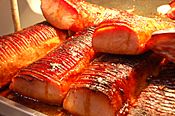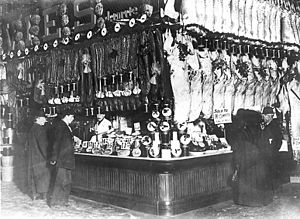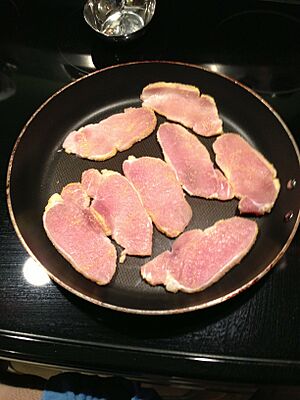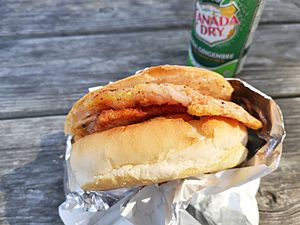Peameal bacon facts for kids

Peameal bacon
|
|
| Place of origin | Canada |
|---|---|
| Region or state | Southern Ontario |
| Associated national cuisine | Cuisine of Canada |
| Main ingredients | Pork loin |
| 157 kcal (657 kJ) | |
Peameal bacon is a special kind of back bacon from Canada. It's made from lean pork loin that's been soaked in a salty-sweet liquid (called "wet-cured"). Then, it's rolled in cornmeal. Unlike regular bacon, it's not smoked. You can find peameal bacon all over Canada and in some parts of England. A man named William Davies, who came to Canada from England in 1854, is often given credit for creating it.
The name "peameal bacon" comes from a long time ago. Back then, the pork was rolled in ground yellow peas. This helped keep it fresh for longer. After World War I, people started using ground yellow cornmeal instead of peas. But the old name stuck!
Peameal bacon sandwiches are very popular, especially in Toronto. They are usually made with cooked peameal bacon on a kaiser roll. Sometimes, people add mustard or other toppings. Many people think this sandwich is a signature dish of Toronto, especially from the city's famous St. Lawrence Market.
Contents
What is Peameal Bacon?
Peameal bacon is a type of back bacon that is not smoked. It's made from the middle part of a pork loin. First, extra fat is trimmed off. Then, the pork is soaked in a special mix of salt and sugar water. This process is called "wet-curing." After curing, it's rolled in cornmeal.
You can cook peameal bacon in different ways. You can slice it and cook it on a grill, in a pan, or fry it. You can also roast a whole piece and then slice it to serve. The way it's cured makes it hard to overcook. It stays juicy because it doesn't have much fat. The cornmeal coating makes its edges crispy when cooked.
When cooked, peameal bacon has a mild salty and sweet taste. It tastes more like fresh ham than regular smoked bacon. The cooked slices look a bit like small pork cutlets. People eat it for breakfast, lunch, or dinner. It can be served on its own or as part of a pork dish.
Why is it Called Peameal?
The name peameal comes from a time when dried yellow peas were ground into a powder. This powder was packed around the meat to keep it fresh. This was common in the Victorian era. Today, cornmeal is used instead of pea meal. But the original name "peameal bacon" is still used.
Peameal bacon is mostly found in Southern Ontario, Canada. Outside of this area, it's often just called "back bacon." A peameal bacon sandwich is also sometimes called "back bacon on a bun."
Some people in the United States call peameal bacon "Canadian bacon." However, this can be confusing. In the US, "Canadian-style bacon" or "Canadian back bacon" often means a different kind of smoked back bacon. This smoked bacon is not actually from Canada. Americans use these names to tell it apart from what they call "American bacon," which is side bacon (also known as streaky bacon).
The History of Peameal Bacon

People have been curing pork with salty water for hundreds of years. So, the idea of curing meat is very old. The exact start of peameal bacon is not fully known. However, it is strongly connected to a pork packer named William Davies. He owned the William Davies Company in Toronto. It's not clear if Davies himself invented the process. It might have been an employee, or he might have learned it from someone else.
William Davies moved to Canada from Britain in 1854. He opened a shop in Toronto's St. Lawrence Market. A popular story in Toronto says that Davies once sent some cured pork loins to his family in England. To help keep the meat fresh during the trip, he packed it in ground yellow peas. His family loved it, and Davies continued to roll cured pork loins in pea meal. This helped the meat stay fresh longer.
The William Davies Company grew very big. It became Canada's first large chain of food stores. It also became the biggest pork exporter in the British Empire. By the early 1900s, the company's factory in Toronto processed almost half a million pigs each year. This is why Toronto earned the nickname "Hogtown." After World War I, cornmeal became easier to get. Also, refrigerators improved. So, cornmeal replaced the pea meal coating.
Peameal Bacon Sandwiches
In the 1960s, a butcher named Joe Hoiner at St. Lawrence Market noticed something. His customers wanted the middle parts of the cured peameal loins. This left him with the ends. He teamed up with Elso Biancolin, who ran a bakery at the market. They started slicing and frying the bacon ends and selling them on buns.
Elso Biancolin's sons, Robert and Maurice, expanded their family's Carousel Bakery in 1977. Their special peameal bacon sandwich, served on a fresh kaiser roll, became very famous. Food critics and TV chefs from all over the world noticed it. Many tourist guides mention it, and visiting chefs often want to try it.
The Carousel Bakery's peameal bacon sandwich is simple. It doesn't have fancy sauces or many layers. It's made with thin slices of peameal bacon. These are cooked on a griddle until they are crispy. Then, a little honey mustard is drizzled on top. It's all served on a soft, fresh roll. You can also choose to add an egg or regular side bacon.
In 2000, this sandwich was served at the first ever Canadian Comedy Awards. In 2016, the peameal bacon sandwich was officially named Toronto's signature dish. Mayor John Tory announced this at a local food festival. Peameal bacon sandwiches were even part of a friendly bet between Mayor Tory and Oakland Mayor Libby Schaaf during the 2019 NBA Finals.
Nutrition Facts
Peameal bacon is quite lean, meaning it doesn't have a lot of fat. This makes it a good choice compared to side bacon. It's also less processed than turkey bacon. Even though turkey bacon often seems healthier, some popular brands have more sodium and carbohydrates from added corn syrup.
A nutritionist named Theresa Albert compared 100 grams (about 3.5 ounces) of different types of bacon:
- Turkey bacon: 382 calories, 2,285 mg of sodium, 3.1 g of carbohydrates, and 28 g of fat.
- Side bacon: 541 calories, 1,717 mg of sodium, 1.4 g of carbohydrates, and 42 g of fat.
- Peameal bacon: 157 calories, 904 mg of sodium, 1.7 g of carbohydrates, and 7 g of fat.
In 2018, a lab tested a 241-gram (about 8.5 ounces) peameal bacon sandwich from Carousel Bakery. It found the sandwich had:
- 499 calories
- 2,520 mg of sodium
- 49 g of carbohydrates
- 8 g of fat
- 57 g of protein
A dietitian named Shannon Crocker said that the calories and protein in the sandwich would make it a satisfying meal. However, she noted that the sodium was 10% higher than the maximum amount recommended for a whole day.



